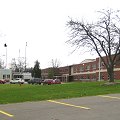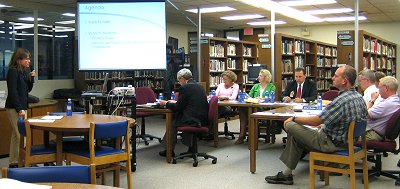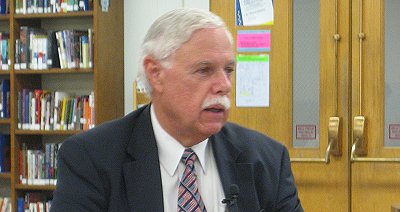- By Dan Veaner
- News
 Print
Print  After years spend developing costly projects that were either voted down or killed before coming to a vote district officials are looking at a different approach. "We've got to start working backwards to say how much we need in a capital reserve, and how much do we have?" said Superintendent Stephen Grimm at a recent school board meeting. "How are we going to build that into our financial planning, instead of spending reactively?"
After years spend developing costly projects that were either voted down or killed before coming to a vote district officials are looking at a different approach. "We've got to start working backwards to say how much we need in a capital reserve, and how much do we have?" said Superintendent Stephen Grimm at a recent school board meeting. "How are we going to build that into our financial planning, instead of spending reactively?"Over the past two months Grimm and Lansing's Board of Education has been finalizing plans for two capital projects that will address the district's most pressing infrastructure needs with little or no cost to the taxpayers. "We need to build trust with our taxpayers," Grimm said. "They need to know what they're getting. The first thing we want to do is get what we can without any cost. That's going to be the combination of the Excel project ($1.1 million) and the energy performance contract (over $4 million). The idea is to combine these two on a December 8th referendum."
In August board President Anne Drake signed an energy performance contract that could save the district $2.82 million over an 18 year period. In September the board concentrated on $410,000 of 'Expanding Our Children's Education and Learning (EXCEL) funding that, with other state aid eligibility could turn into a $1.2 million project.
While the energy performance contract does not require voter approval, the district can realize more money in aid if the voters approve it. The EXCEL project does require a yes vote, and Grimm was determined to ask for that vote on December 8th with zero tax impact.

Architect Pamela Hamel presents project
At the first September meeting Thomas Architect Group's Pamela Hamel presented a summary of the scope of a possible project. In the second meeting the district's financial advisor Bernie Donegan laid out the dollars and cents. Donegan prepared a 42 page document for board members analyzing how the EXCEL aid could be used. It showed how an additional 66.1 cents in building aid per dollar spent could increase the total project.
The first scenario presented a $1,720,000 project that included a new roof for the elementary school, and upper wall panels in that school's gym, exterior high school stairs and a kitchen storage room beneath that. Donegan estimated that the project could cost a taxpayer with a home valued at $100,000 would pay between $1.27 and $2.93 per year for five years, depending on STAR eligibility.
Donegan warned that with the $6.4 billion deficit New York State is facing, EXCEL money is likely to be withdrawn. He estimated that the soonest it would be withdrawn would be next January, but any moneys voted on by taxpayers would remain in place.

Bernie Donegan
"The concern I have is timeliness," Donegan warned. "Well over 90% of the districts have voted and are in various stages of claiming their EXCEL aid. My concern is that they will shut the window on EXCEL aid."
With a December 8 vote planned, that would make it possible to secure the money for Lansing. But it also means a no vote would likely mean losing the money entirely. The question became one of whether to ask for the district's share of the project from the taxpayers or to pay for it from capital reserves.
David Dittman was in favor of asking for the additional money because the amount is so small. He argued that using up the capital reserve would leave the district in the lurch in case of an emergency such as a roof failure. But Grimm was determined to present a project that would have every chance of passing by not asking for additional taxes.
"We discovered there is a $550,000 capital reserve that was established a few years back," he said. "It was never utilized because the capital project was voted down. It's there specifically for this purpose, to reduce the local share."
Grimm said that by using $280,000 from the reserve, the district could ask for permission to spend money the district already has or could get in aid without asking taxpayers to 'place one hand on the voting booth lever while the other is in their wallets.' Additionally he noted that a $300,000 windfall that will come from a PILOT agreement negotiated with AES Cayuga to raise the power plant's assessed value can be used to replace the reserve money to be used for future projects.
He also suggested reducing the scope of the project to just the roof to make the project simple and understandable with no tax impact to maximize its chances of passing.
"People are tired and given the economic conditions and forces that are continuing to be exacerbated by the stock market I don't think we should ask for a penny," he argued. "They have already given us money in the past for capital projects. This is a clear infrastructure improvement that we need. Everybody understands roofs."
Grimm has also said that these free projects are a good first step toward selling district voters on the idea of smaller, stepped capital projects that will address the problems the failed $40 million project sought to address.
"We need to have that be part of our trust building," he said. "A good budget spending money that we've already got. It's a good use of our money for a roof and energy performance items. If we have $40 million worth of infrastructure needs over the next 15 years that we can identify, then we need to divide it up and say that's going to be about $2 million a year. If we want to do it right that's about a $4 million capital project every two years."
----
v4i38



